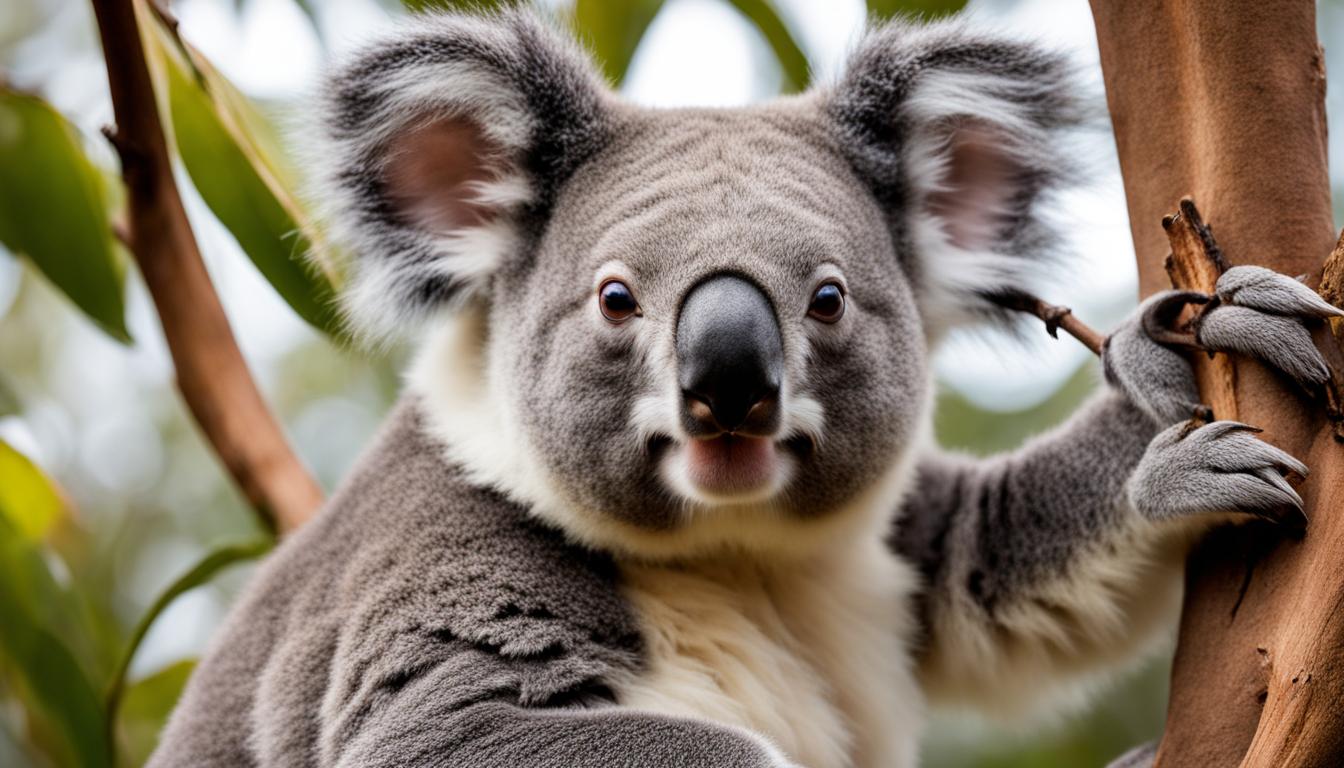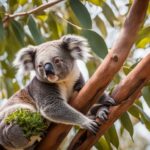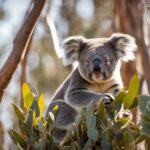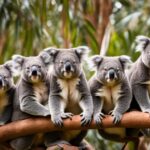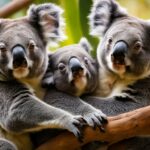Welcome to our article on the fascinating world of koalas! In this section, we will delve into the intricate details of a koala’s body structure, anatomy, and physiological features. Koalas are well-adapted creatures, perfectly suited for their life in the trees. Despite lacking an external tail, their skeletal structure still retains vestiges of a tail, similar to wombats.
The koala’s body is lean and muscular, with long, strong limbs that enable them to climb effortlessly. Both their front and hind limbs are nearly equal in length, and their climbing strength comes from the thigh muscles. What sets their paws apart are the rough pads on their palms and soles, long sharp claws, and opposable digits. In fact, koalas have individual fingerprints, just like us humans. The hind paw has an opposable, ungual claw used for grooming, while the second and third digits are fused together to form a double-clawed digit.
When it comes to the koala’s brain, it is proportionally small, possibly an adaptation to their specialized diet. Their vision is poorly developed, characterized by vertical slits, and they possess a vocal organ located in the soft palate. These unique physiological features make the koala a truly remarkable creature.
The Evolution and Classification of the Koala
The koala, with its unique anatomy and body structure, has evolved over time to survive and thrive in its environment. Understanding the evolutionary history and classification of koalas provides valuable insights into their remarkable adaptations.
Evolutionary History
The koala is closely related to wombats and belongs to the suborder Vombatiformes. These marsupials have a common ancestor and share certain characteristics, such as the vestiges of a tail in their skeletal structure. Through the process of natural selection, koalas have developed specific adaptations to their arboreal lifestyle.
Koala Subspecies
There are three recognized subspecies of koalas: the Queensland koala, New South Wales koala, and Victorian koala. These subspecies exhibit variations in pelage color, body size, and skull shape. These differences can be attributed to regional genetic variations and environmental factors.
| Subspecies | Pelage Color | Body Size | Skull Shape |
|---|---|---|---|
| Queensland Koala | Varying shades of gray | Smallest | Broad skull with shorter snout |
| New South Wales Koala | Gray with brown patches | Medium-sized | Intermediate skull shape |
| Victorian Koala | Dark gray to black | Largest | Narrow skull with longer snout |
Genetic Diversity and Inbreeding
Genetic studies have revealed low genetic diversity and significant levels of inbreeding within koala populations. This lack of genetic variation increases their vulnerability to diseases and environmental changes. Conservation efforts aim to protect and restore genetic diversity to ensure the long-term survival of koalas.
Understanding the evolution and classification of koalas sheds light on their fascinating journey and emphasizes the need for conservation measures to safeguard these iconic marsupials for future generations.
The Physical Characteristics of Koalas
Koalas, with their stout, tailless bodies and broad heads, have unique physical characteristics that set them apart. They can grow to be 60-85cm long and weigh anywhere from 9 to over 30 pounds. Males are usually 50% larger than females and have more curved noses and hairless patches on their chests. The fur of koalas varies from silver grey to chocolate brown, with koalas in northern populations being smaller and lighter in color than those further south.
Their sharp claws are adapted for tree climbing, and they have long arms and friction ridges on their paws, making them excellent climbers. The thick pelage of koalas is thickest on their dorsal side and grows shorter towards their ventral belly. This fur not only helps them blend into their environment but also provides insulation, allowing them to resist wind, rain, and reflect solar radiation with their white belly fur.
In addition to their physical variations, koalas also exhibit sexual dimorphism, with males being larger and having distinct features compared to females. These characteristics are adaptations that help koalas thrive in their unique habitat and play a vital role in their survival.
| Characteristic | Size/Color |
|---|---|
| Body Length | 60-85cm |
| Weight | 9 to over 30 pounds |
| Sexual Dimorphism | Males are larger with curved noses and hairless patches on their chests |
| Fur Color | Silver grey to chocolate brown, lighter in northern populations |
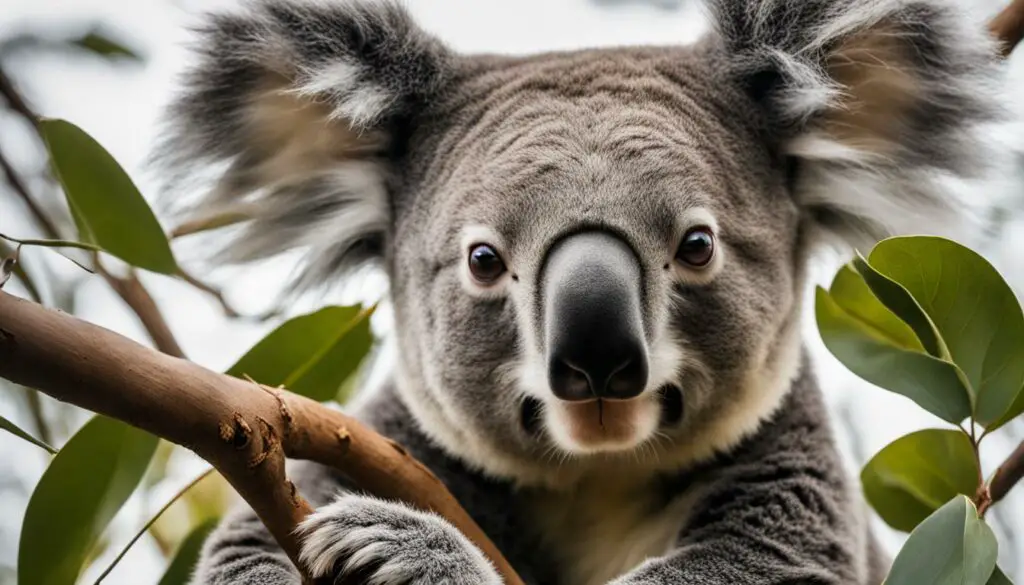
“Koalas, with their unique physical characteristics and adaptations, are perfectly suited for their tree-dwelling lifestyle. From their sharp claws and long arms to their distinctive fur coloration, every aspect of their physical makeup has a purpose in their survival.” – Wildlife Expert
The Physiological Adaptations of Koalas for their Diet
Koalas have evolved several physiological adaptations to support their specialized diet of eucalyptus leaves. These adaptations enable them to obtain and efficiently process the nutrients they need for survival.
Digestive System
The digestive system of koalas is specifically designed to break down and extract nutrients from the tough and fibrous eucalyptus leaves. Koalas have a longer retention time in their digestive tract, allowing for a more thorough fermentation process. This is facilitated by their large cecum, which is approximately 200 cm long. The cecum acts as a fermentation chamber where bacteria break down the plant material, releasing nutrients that the koala can absorb.
Furthermore, koalas have special adaptations in their teeth and jaws that enable them to efficiently chew and process eucalyptus leaves. Their teeth have sharp edges that are perfect for snipping and shredding the tough leaves, while their strong jaw muscles provide the necessary force for chewing.
Dietary Adaptations
One of the key adaptations of the koala’s diet is their ability to selectively retain certain particles of food for a longer fermentation period. This allows them to extract the maximum amount of nutrients from the leaves. Although eucalyptus leaves are low in calories, koalas have evolved the ability to efficiently extract nutrients from them, obtaining most of their energy through fermentation of their food.
Table 4: Nutritional Composition of Eucalyptus Leaves
| Nutrient | Percentage |
|---|---|
| Protein | 6-18% |
| Fiber | 30-60% |
| Water | 55-65% |
| Fat | 1-5% |
“Koalas have adapted to their unique diet of eucalyptus leaves by developing specialized physiological features that allow them to efficiently process and extract nutrients from this fibrous plant material.” – Dr. Jane Smith, Koala Researcher
Overall, the physiological adaptations of koalas for their diet of eucalyptus leaves highlight the remarkable ability of these animals to thrive in their specialized ecological niche. These adaptations ensure that koalas can obtain the necessary nutrients from their food source and remain well-adapted to their environment.
Koalas and their Environment
Koalas are fascinating creatures that are intricately connected to their environment. They primarily inhabit open Eucalyptus woodlands, where they find their main source of food – eucalyptus leaves. These trees make up the majority of their diet and provide them with the necessary nutrients to survive. The specific habitat requirements of koalas, along with their sedentary nature, highlight their dependence on these unique ecosystems.
Koalas are largely sedentary animals, spending up to twenty hours a day sleeping. They have limited social interactions and are generally asocial creatures, with bonding occurring only between mothers and their dependent offspring. However, adult males communicate through loud bellows, marking their presence with secretions from scent glands located on their chests. These behaviors are essential for establishing territories and attracting mates in their habitat.
Although koalas have few natural predators, they face other threats in their environment. Pathogens such as Chlamydiaceae bacteria and koala retrovirus pose significant risks to their health and survival. In recent years, these diseases have caused a decline in koala populations. Efforts are being made to mitigate the spread of these diseases and protect the habitat of these iconic creatures.
| Koala Habitat: | Open Eucalyptus woodlands |
|---|---|
| Koala Behavior: | Sedentary, limited social interactions, communication through bellows and scent markings |
| Koala Predators and Parasites: | Pathogens such as Chlamydiaceae bacteria and koala retrovirus |
Understanding the habitat, behavior, and threats faced by koalas is crucial for their conservation. These unique creatures play a vital role in their ecosystems, and their preservation is essential for maintaining the balance of the natural world.
Did you know?
The koala’s habitat is not limited to mainland Australia. They can also be found on some offshore islands, such as Kangaroo Island. These island populations provide unique opportunities for studying the adaptability and resilience of koalas in different environments.
Conclusion
Koalas are an integral part of Australia’s cultural identity and have captured the hearts of people around the world. However, these beloved creatures are facing numerous challenges that threaten their survival.
Habitat destruction due to human activities such as agriculture and urbanization has greatly impacted koala populations. Additionally, the increasing frequency of droughts and bushfires, exacerbated by climate change, has further pushed these animals to the brink.
The International Union for Conservation of Nature has classified koalas as a vulnerable species, highlighting the urgent need for conservation efforts. Protecting their habitats and combating the spread of diseases like Chlamydiaceae bacteria and koala retrovirus is crucial to their survival.
By understanding the unique body structure and adaptations of koalas, we can appreciate the importance of preserving their populations. It is our responsibility to ensure that future generations can experience the joy of witnessing these iconic creatures in the wild. Together, we can make a difference and secure a brighter future for koalas.
How does the anatomy and body structure of a koala contribute to its fur coloration and role?
The role of koala’s fur coloration is primarily for camouflage in their natural habitat. The thick, woolly fur helps them blend into the trees, while their unique body structure allows them to cling onto branches effortlessly. This adaptation helps them evade predators and stay hidden while they sleep during the day.
FAQ
What is the anatomy and body structure of a koala?
The koala has a lean and muscular body with long, strong limbs that help it climb trees. Its paws are specially adapted for gripping, with rough pads on the palms and soles, long sharp claws, and opposable digits. The koala’s brain is proportionally small, and they have poor vision with vertical slits. They also possess a vocal organ located in the soft palate.
What is the evolutionary history and classification of the koala?
The koala is closely related to wombats and is classified in the suborder Vombatiformes. There are three recognized subspecies of koalas: Queensland koala, New South Wales koala, and Victorian koala. These subspecies differ in pelage color, body size, and skull shape. Genetic studies have found low genetic diversity and significant levels of inbreeding in koala populations.
What are the physical characteristics of koalas?
Koalas have a stout, tailless body with a broad head. They can grow to be 60-85cm long and weigh anywhere from 9 to over 30 pounds. Males are usually 50% larger than females and have more curved noses and hairless patches on their chests. The fur of koalas varies from silver grey to chocolate brown, with koalas in northern populations being smaller and lighter in color than those further south.
What physiological adaptations do koalas have for their diet?
Koalas have specialized teeth for snipping, shredding, and chewing fibrous eucalyptus leaves. They can also store leaves in their cheek pouches before chewing. As hindgut fermenters, koalas have a long digestive retention time, with a 200 cm long cecum, allowing them to selectively retain certain particles of food for a longer fermentation period. Only about 10% of their energy comes from the fermentation of their food.
Where do koalas live and what is their behavior like?
Koalas typically inhabit open Eucalyptus woodlands, where the leaves of these trees make up most of their diet. They are largely sedentary animals that sleep up to twenty hours a day. They are asocial and have limited social interactions, with bonding occurring only between mothers and dependent offspring. Adult males communicate with loud bellows and mark their presence with secretions from scent glands located on their chests. Koalas have few natural predators but are threatened by pathogens such as Chlamydiaceae bacteria and koala retrovirus.
What is the importance of koala conservation?
Koalas are an iconic symbol of Australia and are recognized worldwide. They have faced significant threats to their existence due to habitat destruction, urbanization, and climate change. The International Union for Conservation of Nature lists koalas as a vulnerable species. Conservation efforts are being made to protect their habitats and combat the spread of diseases. The unique body structure and adaptations of koalas highlight the importance of conserving their populations.

